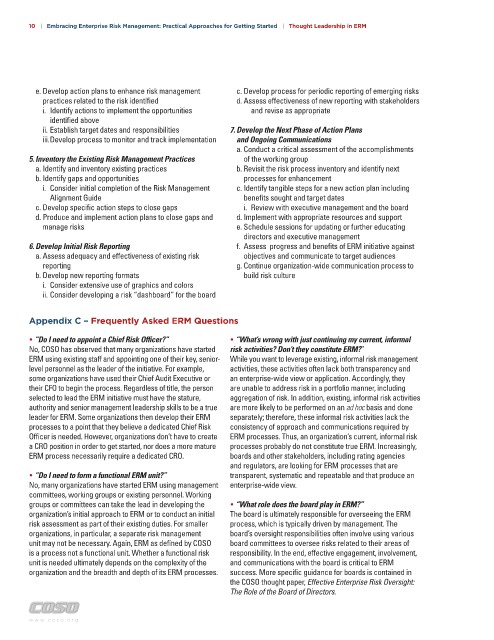Page 679 - COSO Guidance
P. 679
10 | Embracing Enterprise Risk Management: Practical Approaches for Getting Started | Thought Leadership in ERM
e. Develop action plans to enhance risk management c. Develop process for periodic reporting of emerging risks
practices related to the risk identified d. Assess effectiveness of new reporting with stakeholders
i. Identify actions to implement the opportunities and revise as appropriate
identified above
ii. Establish target dates and responsibilities 7. Develop the Next Phase of Action Plans
iii. Develop process to monitor and track implementation and Ongoing Communications
a. Conduct a critical assessment of the accomplishments
5. Inventory the Existing Risk Management Practices of the working group
a. Identify and inventory existing practices b. Revisit the risk process inventory and identify next
b. Identify gaps and opportunities processes for enhancement
i. Consider initial completion of the Risk Management c. Identify tangible steps for a new action plan including
Alignment Guide benefits sought and target dates
c. Develop specific action steps to close gaps i. Review with executive management and the board
d. Produce and implement action plans to close gaps and d. Implement with appropriate resources and support
manage risks e. Schedule sessions for updating or further educating
directors and executive management
6. Develop Initial Risk Reporting f. Assess progress and benefits of ERM initiative against
a. Assess adequacy and effectiveness of existing risk objectives and communicate to target audiences
reporting g. Continue organization-wide communication process to
b. Develop new reporting formats build risk culture
i. Consider extensive use of graphics and colors
ii. Consider developing a risk “dashboard” for the board
Appendix C – Frequently Asked ERM Questions
• “Do I need to appoint a Chief Risk Officer?” • “What’s wrong with just continuing my current, informal
No, COSO has observed that many organizations have started risk activities? Don’t they constitute ERM?”
ERM using existing staff and appointing one of their key, senior- While you want to leverage existing, informal risk management
level personnel as the leader of the initiative. For example, activities, these activities often lack both transparency and
some organizations have used their Chief Audit Executive or an enterprise-wide view or application. Accordingly, they
their CFO to begin the process. Regardless of title, the person are unable to address risk in a portfolio manner, including
selected to lead the ERM initiative must have the stature, aggregation of risk. In addition, existing, informal risk activities
authority and senior management leadership skills to be a true are more likely to be performed on an ad hoc basis and done
leader for ERM. Some organizations then develop their ERM separately; therefore, these informal risk activities lack the
processes to a point that they believe a dedicated Chief Risk consistency of approach and communications required by
Officer is needed. However, organizations don’t have to create ERM processes. Thus, an organization’s current, informal risk
a CRO position in order to get started, nor does a more mature processes probably do not constitute true ERM. Increasingly,
ERM process necessarily require a dedicated CRO. boards and other stakeholders, including rating agencies
and regulators, are looking for ERM processes that are
• “Do I need to form a functional ERM unit?” transparent, systematic and repeatable and that produce an
No, many organizations have started ERM using management enterprise-wide view.
committees, working groups or existing personnel. Working
groups or committees can take the lead in developing the • “What role does the board play in ERM?”
organization’s initial approach to ERM or to conduct an initial The board is ultimately responsible for overseeing the ERM
risk assessment as part of their existing duties. For smaller process, which is typically driven by management. The
organizations, in particular, a separate risk management board’s oversight responsibilities often involve using various
unit may not be necessary. Again, ERM as defined by COSO board committees to oversee risks related to their areas of
is a process not a functional unit. Whether a functional risk responsibility. In the end, effective engagement, involvement,
unit is needed ultimately depends on the complexity of the and communications with the board is critical to ERM
organization and the breadth and depth of its ERM processes. success. More specific guidance for boards is contained in
the COSO thought paper, Effective Enterprise Risk Oversight:
The Role of the Board of Directors.
w w w . c o s o . o r g

